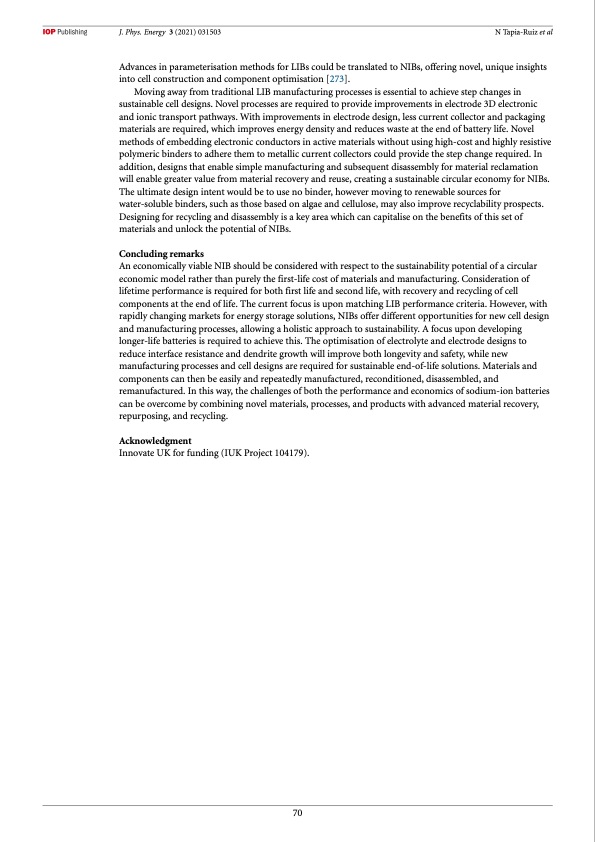
PDF Publication Title:
Text from PDF Page: 071
J. Phys. Energy 3 (2021) 031503 N Tapia-Ruiz et al Advances in parameterisation methods for LIBs could be translated to NIBs, offering novel, unique insights into cell construction and component optimisation [273]. Moving away from traditional LIB manufacturing processes is essential to achieve step changes in sustainable cell designs. Novel processes are required to provide improvements in electrode 3D electronic and ionic transport pathways. With improvements in electrode design, less current collector and packaging materials are required, which improves energy density and reduces waste at the end of battery life. Novel methods of embedding electronic conductors in active materials without using high-cost and highly resistive polymeric binders to adhere them to metallic current collectors could provide the step change required. In addition, designs that enable simple manufacturing and subsequent disassembly for material reclamation will enable greater value from material recovery and reuse, creating a sustainable circular economy for NIBs. The ultimate design intent would be to use no binder, however moving to renewable sources for water-soluble binders, such as those based on algae and cellulose, may also improve recyclability prospects. Designing for recycling and disassembly is a key area which can capitalise on the benefits of this set of materials and unlock the potential of NIBs. Concluding remarks An economically viable NIB should be considered with respect to the sustainability potential of a circular economic model rather than purely the first-life cost of materials and manufacturing. Consideration of lifetime performance is required for both first life and second life, with recovery and recycling of cell components at the end of life. The current focus is upon matching LIB performance criteria. However, with rapidly changing markets for energy storage solutions, NIBs offer different opportunities for new cell design and manufacturing processes, allowing a holistic approach to sustainability. A focus upon developing longer-life batteries is required to achieve this. The optimisation of electrolyte and electrode designs to reduce interface resistance and dendrite growth will improve both longevity and safety, while new manufacturing processes and cell designs are required for sustainable end-of-life solutions. Materials and components can then be easily and repeatedly manufactured, reconditioned, disassembled, and remanufactured. In this way, the challenges of both the performance and economics of sodium-ion batteries can be overcome by combining novel materials, processes, and products with advanced material recovery, repurposing, and recycling. Acknowledgment Innovate UK for funding (IUK Project 104179). 70PDF Image | 2021 roadmap for sodium-ion batteries

PDF Search Title:
2021 roadmap for sodium-ion batteriesOriginal File Name Searched:
roadmap-sodium-ion-batteries_031503.pdfDIY PDF Search: Google It | Yahoo | Bing
Salgenx Redox Flow Battery Technology: Salt water flow battery technology with low cost and great energy density that can be used for power storage and thermal storage. Let us de-risk your production using our license. Our aqueous flow battery is less cost than Tesla Megapack and available faster. Redox flow battery. No membrane needed like with Vanadium, or Bromine. Salgenx flow battery
| CONTACT TEL: 608-238-6001 Email: greg@salgenx.com | RSS | AMP |